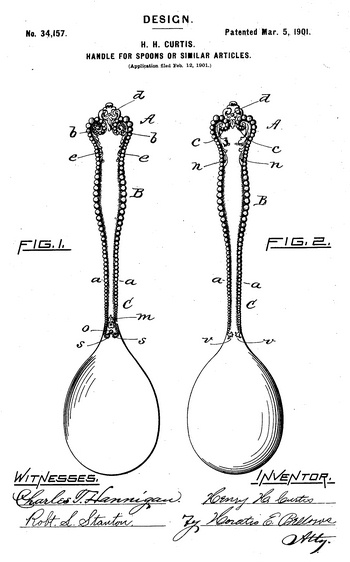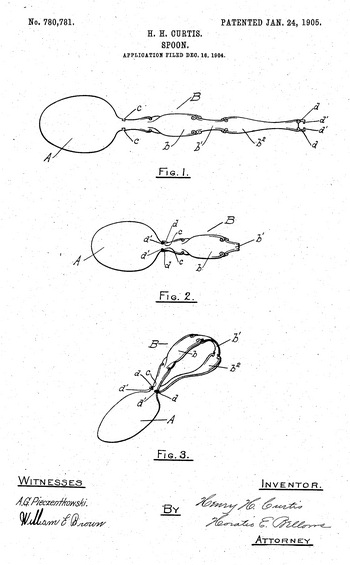Henry Holland Curtis
- Born: 1859, Rhode Island
- Marriage (1): Eva Codding Smith
General notes:
Manufacturer
Events in his life were:
- He appeared on the census in 1880 in Attleboro MA. Listed as a jewelry salesman.
- He worked in 1890-1915 as a silver manufacturer in North Attleboro MA as H. H. CURTIS & Co.

- Patent: 34,157, on 5 Mar 1901. HENRY H. CURTIS, OF NORTH ATTLEBORO, MASSACHUSETTS. DESIGN FOR A HANDLE FOR SPOONS OR SIMILAR ARTICLES.
SPECIFICATION forming part of Design No. 34,157, dated March 5, 1901. Application filed February 12, 1901. Serial No. 47,078. Term of patent 7 years
To all whom it may concern:
Be it known that I, Henry H. Curtis, a citizen of the United States, residing at North Attleboro, in the county of Bristol and State of Massachusetts, have invented a certain new and original Design for the Handle of a Spoon or Similar Article, of which the following is a specification, reference being had therein to the accompanying drawings.
Figure 1 shows the obverse of a spoon-handle containing my design, and Fig. 2 the reverse of the same.
The leading or material features of my design consist in the marginal spherical beading, combined with terminal scroll ornamentation.
In detail my new handle may be described as follows: The marginal ornamentation consists of graduated spherical beads a. The beads which bound the handle-stem C are small and gradually increase in size as they continue upwardly to bound the swelled portion or shank of the handle B. Again the beads diminish in size until the base of the handle-head A is reached, when they again grow larger and terminate in inwardly-directed spirals b b on the obverse, and c c on the reverse, side of the handle. The contour of the head A is completed by a crest d of foliated scrolls surmounting the spirals b and c. The head ornamentation is completed, downwardly - directed foliates within each margin shown on the obverse, as e e, and on the reverse by n n.
The base of the handle-stem has on its obverse side a leaf to, surmounting a circular bead o, which lies immediately above two inwardly-directed circular bead spirals s. The reverse of the stem shows the spherical marginal beading as terminating in inwardly-directed foliates v v.
It is evident that my new design is applicable to the handles of forks and similar articles.
Having thus described my invention, what I claim as new, and desire to secure by Letters Patent, is—
The design for the handle of a spoon or similar article, as herein shown and described.
In testimony whereof I have affixed my signature in presence of two witnesses.
Henry H. Curtis
Witnesses:
Mae E. Bellows
Horatio E. Bellows

- Patent: 780,781, on 24 Jan 1905. HENRY H. CURTIS, OF NORTH ATTLEBORO, MASSACHUSETTS.
SPOON.
SPECIFICATION forming part of Letters Patent No. 780,781, dated January 24, 1905. Application filed December 16, 1904. Serial No. 237,086.
To all whom, it may concern:
Be it known that I, Henry H. Curtis, a citizen of the United States, residing at North Attleboro, in the county of Bristol and State of Massachusetts, have invented certain new and useful Improvements in Spoons, of which the following is a specification, reference being had therein to the accompanying drawings.
My invention relates to baby-spoons, and has for its primary objects increased strength, cheapness, and utility. Originally solder was employed upon spoons of this type to join the extremities of the looped handle to the bowl. The heat required in the soldering process annealed and weakened the structure at its point of greatest strain and defaced the appearance of the product. To avoid the use of solder, such spoons were later constructed with one extremity of the looped handle detached. The free end, however, invited accidental interference with the clothing or body of the infant.
To the above ends my invention consists in the novel structure hereinafter described, and illustrated in the accompanying drawings, wherein—
Figure 1 is a plan elevation of a spoon-blank embodying my invention; Fig. 2, a like view of the same bent into final form and swaged, and Fig. 3 a perspective view of the same.
Like reference - letters indicate like parts throughout the views.
My new spoon and its construction is as follows: From a strip of silver or other suitable metal is stamped and cut by suitable dies a flat blank comprising the bowl A and handle B. The latter has laterally-swelled portions b and b2, intermediate which is a restricted portion b'. The handle has lateral notches e adjacent the bowl, and its extremity is bifurcated, having two prongs or projections d with inwardly-directed extremities d'.
To complete the spoon, the bowl portion A is cupped in the usual manner and the handle B is looped with the swelled portion b in the upper limb of the handle and the portion b2 in the lower limb thereof. The restricted portion b' forms the end of the loop. The prongs d register in the notches c, where the prong extremities are swaged or otherwise inwardly bent over the portion of the handle intermediate the notches.
The restricted or narrowed portion of the handle b' facilitates the handling of the spoon.
Having described my invention, what I claim is—
1. A spoon of the type set forth formed from a single blank comprising a bowl, a handle in loop form upon the bowl, and means upon the handle extremity for engaging the portion of the handle adjacent the bowl.
2. A spoon of the type set forth comprising a bowl, a looped handle integral with the bowl, and prongs upon the handle extremity engaging the portion of the handle adjacent the bowl.
3. A spoon- of the type set forth comprising a bowl, a looped handle integral with the bowl and provided adjacent the bowl with notches, and prongs upon the handle extremity registering in the notches.
4. A spoon of the type set forth comprising a bowl, a looped handle integral with the bowl comprising broad upper and lower limbs and a retracted portion intermediate said limbs, and means upon the handle extremity for engaging the portion of the handle adjacent the bowl.
In testimony whereof I have affixed my signature in presence of two witnesses.
Henry H. Curtis
Witnesses:
Horatio E. Bellows
William E. Brown
Henry married Eva Codding Smith, daughter of Theron Ide Smith and Emily Chloe Codding. (Eva Codding Smith was born in 1860 in Attleboro MA.)
|



